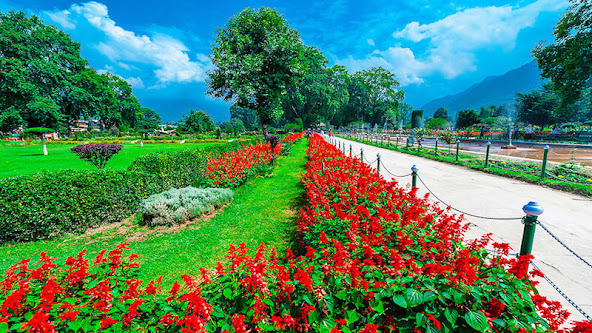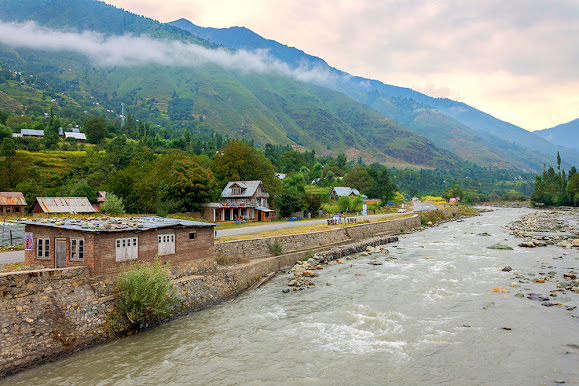Srinagar
Srinagar is a captivating hill station located in the beautiful Indian state of Jammu and Kashmir. Nestled in the Kashmir Valley, it is renowned for its stunning natural beauty, serene lakes, and snow-capped mountains. Srinagar is also known as the "Venice of the East" due to its stunning lakes, intricate houseboats, and breath-taking gardens.
History
Srinagar, located in the beautiful Kashmir Valley of India, is a captivating hill station with a rich history and breath-taking natural beauty. Its history stretches back thousands of years, making it an ideal subject for a detailed blog post. Here's a concise overview of the history of Srinagar for you:
1. Ancient Period: The region of Srinagar has evidence of human settlements dating back to the 3rd century BCE. It was a part of the Mauryan and Kushan empires, and later came under the rule of various dynasties, including the Guptas and the Karkotas.
2. Islamic Era: In the 14th century, Srinagar fell under the rule of the Muslim sultanate of Kashmir. This period saw the influence of Persian and Islamic culture in the region, with the construction of beautiful mosques, gardens, and palaces.
3. Mughal Influence: During the 16th century, Srinagar became a favourite retreat for Mughal emperors, who were captivated by its scenic beauty. The Mughals built several gardens, such as the famous Shalimar Bagh and Nishat Bagh, which are still major attractions today.
4. Sikh and Dogra Rule: In the early 19th century, Srinagar came under the control of the Sikh Empire, and later, the Dogra dynasty. The Dogras developed the infrastructure of the city and established the Hari Parbat Fort.
5. British Rule: With the arrival of the British in India, Srinagar became a part of the princely state of Jammu and Kashmir under the overall suzerainty of the British Raj. The British were drawn to Srinagar's pleasant climate and picturesque landscapes.
6. Post-Independence: Following India's independence in 1947, Srinagar became a part of the newly formed Dominion of India. However, the region faced political turmoil, and the issue of Kashmir's status remains a complex and unresolved matter between India and Pakistan.
7. Tourism Development: Srinagar has long been a popular tourist destination, attracting visitors with its serene Dal Lake, charming houseboats, lush gardens, and iconic Mughal architecture. Despite occasional unrest, tourism continues to play a significant role in the local economy.
Today, Srinagar stands as a symbol of natural beauty and cultural heritage, offering visitors a unique blend of history, art, and breath-taking landscapes. The city's history and enchanting surroundings make it an ideal choice for travellers seeking an immersive hill station experience.
Culture
Srinagar offers a unique cultural experience that attracts visitors from around the world.
1. Kashmiri Cuisine: The culinary traditions of Srinagar reflect the region's cultural diversity. The traditional Kashmiri cuisine is known for its aromatic flavours and generous use of spices. Some popular dishes include Rogan Josh (a flavourful lamb curry), Yakhni (a yogurt-based curry), and Dum Aloo (spiced potatoes cooked in a rich gravy). Wazwan, a grand multi-course feast, is a highlight of Kashmiri cuisine and is often served on special occasions.
2. Arts and Crafts: Srinagar has a rich tradition of arts and crafts that showcase the local craftsmanship. The intricate designs of Kashmiri carpets, known as "Kashmiri rugs," are famous worldwide for their detailed patterns and exquisite craftsmanship. Pashmina shawls, embroidered textiles, and wooden handicrafts like carved walnut wood furniture and papier-mâché products are also popular souvenirs for visitors.
3. Festivals and Celebrations: Srinagar celebrates a variety of festivals that offer a glimpse into the region's cultural tapestry. One of the most important festivals is Eid-ul-Fitr, which marks the end of Ramadan and is celebrated with great enthusiasm. The annual Tulip Festival held in the Indira Gandhi Memorial Tulip Garden showcases the blooming flowers and attracts tourists from far and wide. Additionally, the Shivratri Festival, Navroz (Parsi New Year), and Diwali are celebrated with fervor.
4. Music and Dance: Srinagar is known for its vibrant music and dance traditions. The traditional music of Kashmir, known as Sufiana Kalam, features soulful melodies and poetic lyrics that evoke deep emotions. The Santoor, a traditional Kashmiri instrument, is a prominent part of the region's music. Traditional Kashmiri dance forms like Rouf, Hafiza, and Bhand Pather are performed during festivals and cultural events, showcasing the graceful movements and colourful costumes.
5. Houseboats and Dal Lake: Srinagar's unique cultural experience is enhanced by its houseboat culture and the scenic Dal Lake. Staying in a traditional houseboat, locally known as a "Shikara," is a popular choice for tourists. These intricately designed wooden boats provide a comfortable and memorable stay on the Dal Lake, allowing visitors to immerse themselves in the serene beauty of the surroundings.
Srinagar's culture is a beautiful blend of art, cuisine, festivals, and natural splendour. It offers visitors an opportunity to explore and appreciate the region's unique traditions and immerse themselves in the warmth and hospitality of the local people.
How to reach
To reach Srinagar, a popular hill station in India, you have a few transportation options depending on your starting point:
1. By Air: If you prefer a faster mode of travel, you can take a flight to Srinagar International Airport (SXR). Several domestic airlines operate regular flights from major cities in India to Srinagar. Once you land at the airport, you can hire a taxi or use public transportation to reach your desired location within Srinagar.
2. By Train: The nearest railway station to Srinagar is Jammu Tawi Railway Station, located approximately 290 kilometres away. From there, you can hire a taxi or take a bus to Srinagar. The road journey from Jammu to Srinagar offers beautiful scenic views.
3. By Road: Srinagar is well-connected to major cities in northern India by road. You can either drive your own vehicle or take a bus. The journey can be quite long, so it's advisable to plan for breaks along the way. The most common route is via the Jammu-Srinagar National Highway (NH44).
Once you reach Srinagar, you can explore various attractions and activities in and around the hill station. Also, don't miss the opportunity to savour the local cuisine, which includes famous dishes like Rogan Josh and Kashmiri Pulao.
Capture stunning photographs, document your experiences, and engage with the local culture to create compelling content for your blog. Remember to respect local customs and traditions, and be mindful of any guidelines or restrictions that may be in place during your visit.
Places to visit
Here are some of the top places to visit in Srinagar:
1. Dal Lake: This iconic lake is one of the major attractions in Srinagar. Take a shikara ride on the tranquil waters, visit the floating gardens, and explore the vibrant houseboats that dot the lake.


2. Mughal Gardens: Srinagar is famous for its exquisite Mughal Gardens. Nishat Bagh, Shalimar Bagh, and Chashme Shahi are the most popular ones. These gardens feature stunning terraced lawns, vibrant flower beds, and beautiful fountains.


3. Shankaracharya Temple: Perched on top of a hill, this ancient temple offers breath-taking views of Srinagar and the surrounding mountains. It is a revered Hindu pilgrimage site and holds great religious significance.

4. Hazratbal Shrine: Located on the banks of Dal Lake, this shrine is a revered Muslim shrine in Srinagar. The shrine houses a holy relic believed to be a strand of hair from the Prophet Muhammad.

5. Pari Mahal: This historic monument is a terraced garden that offers panoramic views of Srinagar. It is known for its beautiful architecture, landscaped gardens, and as a centre of learning in the past.

6. Wular Lake: Situated near Srinagar, Wular Lake is the largest freshwater lake in India. It is a paradise for birdwatchers and nature lovers, with a wide variety of avian species and scenic surroundings.


7. Gulmarg: Just a short drive from Srinagar, Gulmarg is a popular skiing destination and a picturesque hill station. It offers breath-taking views of snow-capped mountains, vast meadows, and opportunities for adventure sports.


8. Sonamarg: Known as the "Meadow of Gold," Sonamarg is a scenic hill station located on the Srinagar-Leh Highway. It is surrounded by snow-covered peaks, alpine meadows, and gushing rivers, making it an ideal destination for nature enthusiasts.


9. Pahalgam: Another nearby town, Pahalgam, is renowned for its picturesque landscapes, pristine rivers, and trekking opportunities. It serves as a base camp for the famous Amarnath Yatra.

10.Jama Masjid: This grand mosque is an architectural marvel located in the heart of Srinagar's old city. It showcases intricate woodwork and stunning craftsmanship, attracting visitors for its cultural and historical significance.

When visiting Srinagar, make sure to savour the local cuisine, experience the traditional Kashmiri culture, and indulge in shopping for exquisite handicrafts and traditional textiles.
Accommodation
Srinagar offers a wide range of accommodation options to suit different budgets and preferences. Here's a concise overview of the types of accommodations available in Srinagar.
1. Houseboats: Srinagar is famous for its houseboats, which are traditional wooden boats converted into floating accommodations on the Dal Lake and Nigeen Lake. These houseboats offer a unique experience, providing comfortable rooms with attached bathrooms, living areas, and often a personal caretaker or cook.
2. Hotels and Resorts: Srinagar has numerous hotels and resorts catering to different budgets and preferences. From luxury 5-star hotels to mid-range and budget options, you can find a variety of accommodations offering comfortable rooms, modern amenities, and sometimes stunning views of the surrounding landscapes.
3. Guesthouses and Homestays: For a more personalized and local experience, guesthouses and homestays are a great option. These establishments are often family-run, providing a warm and welcoming atmosphere. Guests can enjoy comfortable rooms, home-cooked meals, and the opportunity to interact with the locals, gaining insights into their culture and traditions.
4. Government Accommodations: Jammu and Kashmir Tourism Development Corporation (JKTDC) operates a range of government-run accommodations in Srinagar, including guesthouses, hotels, and huts. These options are often affordable and provide decent facilities for budget travellers.
5. Luxury Resorts: If you're seeking a lavish experience, Srinagar has some exquisite luxury resorts nestled amidst scenic surroundings. These resorts offer world-class amenities, spa facilities, fine dining restaurants, and breath-taking views, ensuring a truly indulgent stay.
Conclusion
Srinagar
is a captivating hill station that offers a perfect blend of natural beauty,
cultural richness, and thrilling adventures. From the serene lakes and Mughal
gardens to the vibrant markets and mouth-watering cuisine, this destination has
something for everyone. Despite occasional challenges, Srinagar remains a gem waiting
to be explored, leaving visitors with unforgettable memories and a yearning to
return to its enchanting embrace.


